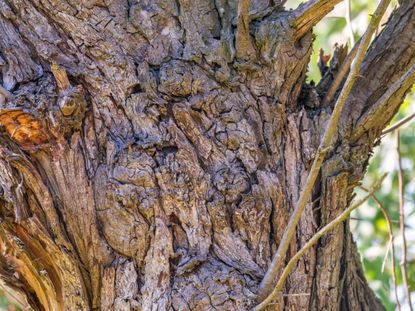Poplar Tree Cankers – Learn About Canker Disease In Poplar Trees


Cankers are physical deformities that may indicate a serious poplar tree disease. They are often the first in a series of symptoms that can end in the death of the tree. Learn about canker disease in poplar trees in this article.
Cankers on Poplar Trees
The microscopic organisms that cause poplar tree diseases enter the tree through wounds and breaks in the bark. A canker, or dark, sunken area on a branch or trunk, gradually spreads around the tree. If it grows to cover half or more of the circumference of the trunk, the tree will probably die. Cankers on branches cause the branch to wither and die, and the disease can spread to the trunk.
You can’t cure canker diseases of poplar, but you may be able to keep them from spreading and further damaging the tree. It’s also important to prevent the disease from spreading to nearby trees. Weak, sickly trees are more likely to develop cankers than strong, healthy ones. If a single tree has canker problems, you might want to consider removing the sick tree to save surrounding trees.
The most common canker tree diseases look similar, but they are likely to attack different species. Here is a short list of diseases that cause poplar tree cankers:
- You’re most likely to find Cytospora chrysosperma and Leucocytospora nivea on Simon, Carolina, Lombardy, and Silver-leaf poplars, but the other species of poplar can get a mild case of the disease too.
- Crytodiaporthe populea is most severe on Lombardy poplar trees. Most other species are resistant.
- Hypoxylon mammatum infects white poplars. You’ll also find it on quaking and European aspens and pussy willows.
Treating/Preventing Poplar Canker Diseases
Keeping your trees healthy is the first step in preventing canker diseases. Water the tree during prolonged dry periods and fertilize when necessary. Poplar trees growing in good soil won’t need fertilizer every year, but if the stems add fewer than 6 inches (15 cm.) of new growth in spring and the leaves look smaller and paler than last year, it’s a good idea to go ahead and fertilize.
Poplar tree cankers are caused by fungi that enter through injuries. Take care when performing landscape maintenance so that you don’t damage the bark with a string trimmer or hit the tree with flying debris from a lawn mower. Broken branches should be pruned to eliminate ragged edges. Prune to shape the tree while the tree is young to keep pruning wounds small.
Early detection of cankers on poplar trees might make it possible to treat a tree and keep it alive for many years. Remove branches with cankers to prevent spread of the disease. Fertilize infected trees annually in spring and water often enough to keep the soil moist to a depth of 6 inches (15 cm.). Good care goes a long way toward extending the life of your tree.
Gardening tips, videos, info and more delivered right to your inbox!
Sign up for the Gardening Know How newsletter today and receive a free download of our most popular eBook "How to Grow Delicious Tomatoes."

Jackie Carroll has written over 500 articles for Gardening Know How on a wide range of topics.
-
 Urban Composting Guide: How To Compost In The Middle Of The City
Urban Composting Guide: How To Compost In The Middle Of The CityUrban composting does not have to be daunting. You can compost in the city, and maybe even try some urban worm composting!
By Mary Ellen Ellis
-
 Shrub Diseases And Pests To Watch Out For
Shrub Diseases And Pests To Watch Out ForShrub diseases and pests can be challenging. Learn how to recognize and eradicate them before they can present a danger to your plants.
By Susan Albert
-
 Lombardy Poplar Facts – Guide To Lombardy Poplar Care In The Landscape
Lombardy Poplar Facts – Guide To Lombardy Poplar Care In The LandscapeIf you read up on Lombardy poplar tree facts, you'll find that these trees offer advantages but also many disadvantages. For more information about Lombardy poplars in landscapes, this article will help.
By Teo Spengler
-
 Bud Gall Mite Insects On Poplar Trees – Tips On Poplar Bud Gall Mite Treatment
Bud Gall Mite Insects On Poplar Trees – Tips On Poplar Bud Gall Mite TreatmentMicroscopic though they are, bud gall mites can do significant esthetic damage to trees like poplars, cottonwoods and aspens. If you have these poplar tree pests, you?ll want to read up on procedures for getting rid of eriophyid mites on poplars. This article will help.
By Teo Spengler
-
 Growing Poplar Trees: Information And Tips For Planting Hybrid Poplar Trees
Growing Poplar Trees: Information And Tips For Planting Hybrid Poplar TreesHomeowners love growing poplar trees because these American natives shoot up fast, bringing shade into backyards. Are poplar trees good or bad as shade trees? Learn the factors that you must consider before growing poplar trees in this article.
By Teo Spengler